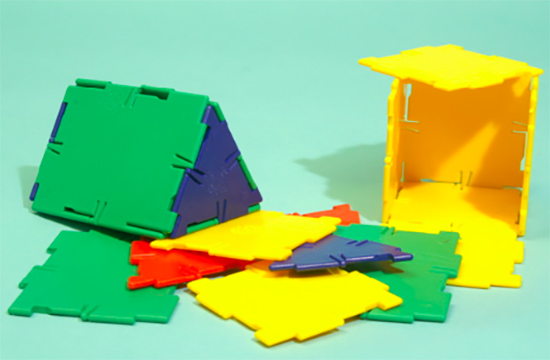E2.5 Create and use nets to demonstrate the relationship between the faces of prisms and pyramids and their surface areas.
Activity 1: Visualizing the Net of a Pyramid and a Prism
Material
Coloured plastic geometric shapes, solid or hollow, with sides of equal length, that attach to each other with light pressure to create three-dimensional objects.

Instructions
Build a prism and a pentagon-based pyramid with Polydrons.
Show the two three-dimensional objects to students and facilitate a discussion using the ”visualize, verbalize, verify" (VVV) strategy.
Ask students to visualize the net of the prism and the pyramid.
Ask them to verbalize with a partner the net of each of the three-dimensional objects. If necessary, provide students with dot or grid paper so that they can trace the way they visualize the net of the prism and the pyramid.
Give students the opportunity to verify their thinking by unfolding each of the three-dimensional objects' nets and asking them to compare it with what they had visualized.
Activity 2: Relationship Between Prisms and Pyramids
Material
- 2 sets of pyramids (square-based, triangle-based, rectangle-based, pentagon-based, hexagon-based and octagon-based)
- 2 sets of prisms (square-based, triangle-based, rectangle-based, pentagon-based, hexagon-based and octagon-based)
- sheets of construction paper
Instructions
Form teams of two students.
Give each team either a prism or pyramid and a sheet of construction paper.
Ask teams to draw all the faces of their prism or pyramid and cut them out.
Pool the results and create a summary table on chart paper as follows.
- Create one row per pyramid and per prism.
- On each row, glue first the base and then the sides that the students have cut out.
- Start with the triangle-based prism and the triangle-based pyramid.
- Continue with the prism and the pyramid with a square base, rectangular base, pentagonal base, hexagonal base and octagonal base.
Ask students to identify the properties of prisms and pyramids, using evidence from the chart. For example :
The side faces of prisms are rectangles and the side faces of pyramids are triangles.
The base of the pyramid determines its name.
The number of sides of the base determines the number of side faces.
Source: adapted and translated from L'@telier - Ressources pédagogiques en ligne (atelier.on.ca).
Activity 3: Visualize, Verbalize and Verify (VVV) Nets
Present a net of a pyramid and a net of a prism to students.
Ask them to visualize the three-dimensional object that each net will produce.
Ask them to verbalize their ideas with a partner.
Ask them to verify what they had visualized by cutting out and creating the three-dimensional object represented by each net.
Facilitate a mathematical conversation to highlight:
- the relationships between the faces of prisms and pyramids
- the idea that the surface area of the net is the sum of the area of all faces.
